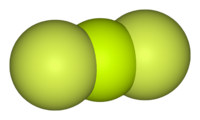| Linear molecular geometry | |
|---|---|
 | |
| Examples | Carbon dioxide CO2 Xenon difluoride XeF2 |
| Point group | D∞h |
| Coordination number | 2 |
| Bond angle(s) | 180° |
| μ (Polarity) | 0 |

The linear molecular geometry describes the geometry around a central atom bonded to two other atoms (or ligands) placed at a bond angle of 180°. Linear organic molecules, such as acetylene (HC≡CH), are often described by invoking sp orbital hybridization for their carbon centers.

According to the VSEPR model (Valence Shell Electron Pair Repulsion model), linear geometry occurs at central atoms with two bonded atoms and zero or three lone pairs (AX2 or AX2E3) in the AXE notation. Neutral AX2 molecules with linear geometry include beryllium fluoride (F−Be−F) with two single bonds, carbon dioxide (O=C=O) with two double bonds, hydrogen cyanide (H−C≡N) with one single and one triple bond. The most important linear molecule with more than three atoms is acetylene (H−C≡C−H), in which each of its carbon atoms is considered to be a central atom with a single bond to one hydrogen and a triple bond to the other carbon atom. Linear anions include azide (N=N=N) and thiocyanate (S=C=N), and a linear cation is the nitronium ion (O=N=O).
Linear geometry also occurs in AX2E3 molecules, such as xenon difluoride (XeF2) and the triiodide ion (I−3) with one iodide bonded to the two others. As described by the VSEPR model, the five valence electron pairs on the central atom form a trigonal bipyramid in which the three lone pairs occupy the less crowded equatorial positions and the two bonded atoms occupy the two axial positions at the opposite ends of an axis, forming a linear molecule.
See also
References
- Housecroft, C. E.; Sharpe, A. G. (2004). Inorganic Chemistry (2nd ed.). Prentice Hall. p. 43. ISBN 978-0-13-039913-7.
- Greenwood, N. N.; Earnshaw, A. (1997). Chemistry of the Elements (2nd ed.). Oxford: Butterworth-Heinemann. ISBN 0-7506-3365-4.
- Housecroft, C. E.; Sharpe, A. G. (2004). Inorganic Chemistry (2nd ed.). Prentice Hall. p. 47. ISBN 978-0-13-039913-7.
External links
- Indiana University Molecular Structure Center
- Interactive molecular examples for point groups
- Molecular Modeling
- Animated Trigonal Planar Visual
| Molecular geometry | |
|---|---|
| Coordination number 2 | |
| Coordination number 3 | |
| Coordination number 4 | |
| Coordination number 5 | |
| Coordination number 6 | |
| Coordination number 7 | |
| Coordination number 8 | |
| Coordination number 9 | |